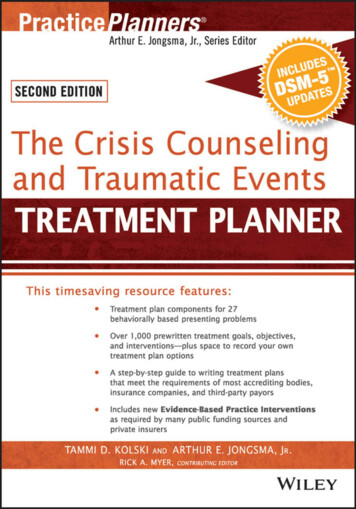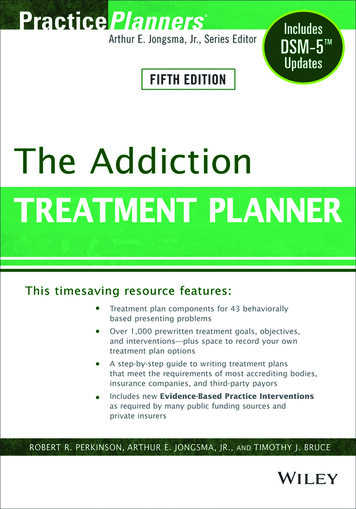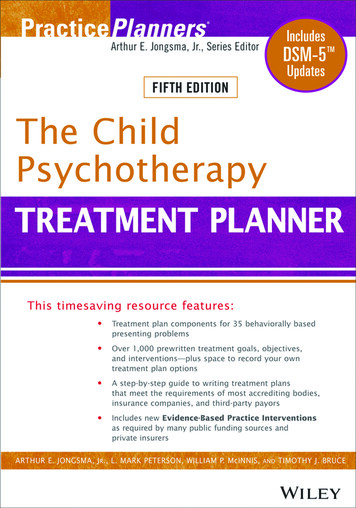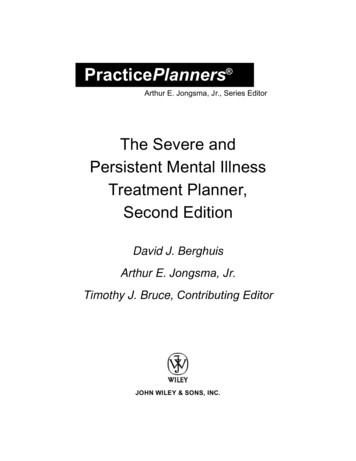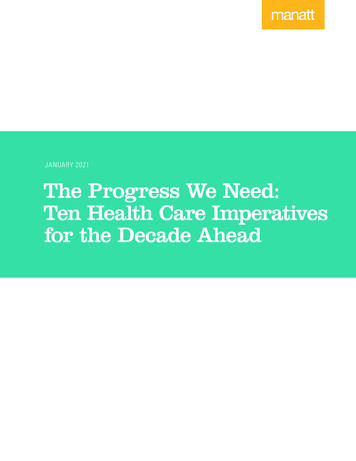
Transcription
JANUARY 2021The Progress We Need:Ten Health Care Imperativesfor the Decade Ahead
The Progress We Need:Ten Health Care Imperatives for the Decade AheadThe Progress We Need: Ten Health CareImperatives for the Decade AheadAs we make the turn into the new decade, we at Manatt Health look forward with cautious optimism to whatthe coming years will bring. The level of citizen engagement in supporting our democratic institutions and thecollective outpouring of effort to protect the right to vote, to beat back the pandemic, to join the fight againstracial injustice and to improve access to health care are building blocks for the society we want to live in.This report addresses the health care imperatives that we believe are critical for improving our health caresystem and advancing health equity. These are the imperatives that form the core of our health care practice.The first two imperatives—ensuring access for all and achieving health equity—are overarching requirementsthat must be collectively achieved for a just health care system.Stabilizing the safety net and rebuilding our public health infrastructure are necessary pillars for a resilienthealth system. The weakness in our health system’s underlying infrastructure has been exposed duringthe pandemic, as has its lack of equity. Creating a just health care system requires us to address socialdeterminants and to align our resources to health improvement and health outcomes.We follow with the imperatives to help our children develop to their full potential and support elders withinnovative new models enabling them to live longer, healthier lives with dignity. Accelerating the broadand equitable use of digital health capabilities will deliver on the promise of virtual care, helping us achievebetter value for our health care spend and reallocating resources so that we can eliminate health disparities.Advancing and sustaining academic medicine will provide the continued innovation needed in order toanticipate and respond to the emergencies of the future, open up new therapeutic frontiers, and helpmeet the growing, aging and diversifying population’s demand for clinicians. Delivering the new class ofManatt Health manatt.com 2
The Progress We Need:Ten Health Care Imperatives for the Decade Aheadpersonalized therapeutics will require public and private payers to find innovative ways to price so as toprovide affordable access. The accelerating transition to a digitally based society requires extraordinaryattention to securing health care privacy. We believe that new policies to ensure this are imperative.Each of these imperatives will need to be met while simultaneously bending the curve on health care costgrowth, by focusing on high-value care, reducing complexity and aligning incentives. It will require bold andactivist leadership to meet these many challenges and deliver on the promise of a just health care system thatwill serve all with excellence, compassion and fairness.Ensuring Access to Coverage and Care1Access to coverage and care is the linchpin of a high-functioning health care system—onethat provides quality care and enables health. Coverage gaps not only harm people, theycreate inefficiencies and preventable costs. With the passage of the Affordable Care Actin 2010, the country began to move in the right direction toward universal coverage. Thenumbers of uninsured began to go down, and with more individuals covered, payerspayers and policymakers were positioned to consider how best to deliver value-basedcare and address social determinants of health (SDOH).In 2019, however, the number of Americans without health insurance, and those underinsured, increasedfor the third consecutive year, despite a growing economy. Recent policies undermined access to coverageand care in both the public and private markets. We see this in policies that weaken coverage standardsfor Marketplace plans, condition Medicaid coverage on work requirements and unaffordable premiums,restrict access to family planning, and make it more difficult for immigrants and LGBTQ individuals to accesscoverage and care. At the same time, decades of neglect of our public health infrastructure became glaringlyobvious as the COVID-19 pandemic focused a spotlight on the gaps in coverage and care and related socialand economic disparities, including stunning disparities in the impact of the pandemic on people of color.Affordable coverage is essential to remedy theseissues. Having forgone years of enhanced federalsupport while many residents remain uninsured,states that have yet to expand Medicaid will belooking to test innovative ideas to strengthencoverage and improve access. At the same time,we expect to see the Biden administration use itsexecutive authority to engage with states open toexpanding Medicaid coverage—and work with allstates to leverage Medicaid in promoting healthequity and reducing health disparities, includingby permitting states to expand postpartumMedicaid coverage to address the maternalmortality and morbidity chasm for Black women.The incoming Biden administration also is likelyto reinvigorate Marketplace outreach andManatt Health manatt.com 3
The Progress We Need:Ten Health Care Imperatives for the Decade Aheadenrollment efforts (such as special enrollment periods) and pursue other policies to promote comprehensive,affordable coverage. States will likely explore innovation here too, by, for example, adopting a Basic HealthPlan or seeking Section 1332 waivers to test policies such as state-based public options or enhancedMarketplace subsidies that lay the groundwork for future federal legislation. States will also continue to buildnew data infrastructure to monitor statewide, cross-payer access, utilization, and cost trends (e.g., all-payerclaims databases, benchmarking), and to develop more targeted and effective system reforms.At the federal level, we can expect the Biden administration to use the authorities of the Affordable Care Actto continue to test payment and delivery reforms, building on a bipartisan consensus to move our health caresystem from paying for volume to rewarding value.Achieving Health Equity Through Collective and Sustained ActionsFor far too long, gaps in health access and outcomes for people of color have persistedand worsened. Compared with White counterparts, people of color are more likely to beuninsured, face barriers in getting needed care, be at a higher risk for a number of healthconditions, and experience poorer health outcomes and premature death. The causes ofthese disparities are deeply rooted in and inextricably linked to systemic racism in oursociety.2The confluence of the public health emergency, economic crisis and racial justicereckoning has put in sharp focus that health equity is a foundational imperative for all health careorganizations. Health care leaders are being called to expand their view of health to include social, economicand environmental factors and to commit to the sustained learning, intentional action and investmentnecessary to build trust and advance health equity. The work to integrate health equity commitmentsinto every organization’s strategic development must be a singular priority for the decade. So too musthealth equity be an essential component of government reforms. Opportunities to align equity with othercore strategic priorities, including quality and community engagement, should be sought and developed.Standardized collection of race and ethnicity data should be pursued by states, payers and providers to betterunderstand, address and monitor inequities.At the forefront in realizing these opportunities will be anchor institutions such as safety net hospitals,Federally Qualified Health Centers (FQHCs), Medicaid health plans, and academic health centers and othersafety net institutions that have been on the front line in addressing systemic factors that lead to poorhealth outcomes. Government agencies, foundations, corporations and other organizations that wieldsignificant economic sway and are invested in the health and well-being of their communities will be essentialcontributors and in some cases drivers. These organizations have the potential to design, incentivize andimplement new models to advance health equity, such as building inclusive boards and leadership teams,engaging in inclusive hiring practices, spurring economic growth by procuring from local enterprises, andbuilding and deepening relationships with community organizations through community benefit dollars andother investment.Manatt Health manatt.com 4
The Progress We Need:Ten Health Care Imperatives for the Decade AheadStabilizing the Safety Net and Rebuilding Public Health CapacitySafety net organizations, including hospitals, FQHCs and community-based organizations,face an existential crisis as rapid changes in health care payment and delivery threatentheir sustainability, creating an expanding chasm in care for underserved communities,both urban and rural. Payment and delivery structures that favor acute and/or emergencycare in lieu of primary care continue to foster suboptimal care delivery for thesepopulations. Urgent and concerted action at the federal and state levels to deliver thefunding necessary to strengthen the safety net will be essential. In concert, there is anurgent need to better align how safety net organizations are structured for community-based care. Newpayment models for safety net hospitals should be further tested and deployed, such as global payment,which can be used to reposition rural hospitals into primary and distributed care.3Compounding the stresses on the safety net, SARS-CoV-2 revealed the fragility of our nation’s public healthinfrastructure. The speed, scale and impact of the pandemic illuminated weaknesses in our abilities toidentify, monitor, contain and cure a rapidly emerging infectious disease. The pandemic also exposed andexacerbated systemic health inequities, vulnerabilities due to social determinants of health (SDOH) and thepervasiveness of preventable chronic diseases. Further, foundational flaws in our public health infrastructurecontinue to be revealed as states struggle to maintain the coverage and care structure required for testing,treating and ultimately vaccinating their residents.Underinvestment has been a central cause for the decay in thepublic health infrastructure, resulting in erosion of expertise andIn recent years, the publicstagnant information systems. Nevertheless, as we discoveredhealth system has beenduring our work this year with city, county and state governments;plagued by underinvestment,health systems; foundations; and policymakers, coordination andan eroding base of expertisecommunication resulted in powerful action to mitigate the worstand a parochial patchworkeffects of the pandemic. Hospitals and health systems mobilizedof information systems.incident command centers to respond in the face of staff, equipmentContinued cuts in federaland critical resource shortages. State and local public healthfunding over the pastauthorities rapidly stood up data collection, reporting and analyticthree decades have greatlytools to inform critical public health and economic decisions.weakened public healthHealth plans regularly communicated with their members on theagencies. Between 2008importance of testing and also worked with providers to mitigateand 2017, the local healthimpacts on their operations and revenue. And the life sciencedepartment workforceindustry responded with effective treatments and, most recently,decreased by 50,000.vaccines. The pandemic response, while revealing many flawsin our emergency preparedness, provided us with new insightsnecessary to reimagine and rebuild a public health system thatwill be ready for the next emergency. This newly energized public health capacity will be underpinned bycommunication and data exchange connections that provide timely, accurate, reliable and actionable data.Manatt Health manatt.com 5
The Progress We Need:Ten Health Care Imperatives for the Decade AheadAddressing Social Determinants so as to Improve Health forAll AmericansThe COVID-19 pandemic has cast a harsh light on the extent to which affordable and safe4housing, education, sustained income, food, schools and living environments—nowcommonly referred to as social determinants of health—are integral to health and wellbeing. Those hardest hit by the pandemic are low-income communities and communitiesof color that are experiencing higher rates of infection and therefore of hospitalizations anddeath. These communities are also disproportionately impacted by downstreamsocioeconomic instability and the isolation and stress resulting from the twin health andeconomic crisis. The crisis has underscored just howcritical the linkages between social services andphysical and behavioral health care are to thewell-being of communities across the country. It hasalso highlighted the high downstream cost of notaddressing the upstream drivers of poor health.State Medicaid programs are leading the way inthinking creatively about addressing SDOH. Statesare designing responsive SDOH interventions,developing sustainable financing models,evaluating the benefits from SDOH-relatedinvestments to promote scaling of effectiveinterventions, and supporting the development ofnew collaborations across sectors, such as healthcare, housing, employment and education. SDOHstrategy development requires a greater role forcommunity-based organizations in solution design,as their expertise is essential to ensuring SDOHinterventions are responsive to the needs of thecommunities and people they are intended toserve. Investments in SDOH will serve a vital function in bending the cost curve, with prevention and earlyintervention initiatives resulting in reduced chronic disease and downstream medical costs.Helping Our Children Reach Their Full Potential5Disruptions to health care, education and community life due to the pandemic havebeen devastating for the health and development of our nation’s children. School closuresand remote learning have not only wreaked havoc for working parents and redefined theAmerican educational experience, they have prevented access to critical early interventionand school-based health care services for children, such as speech, physical andoccupational therapy. After decades of improvement, compliance with recommendedManatt Health manatt.com 6
The Progress We Need:Ten Health Care Imperatives for the Decade Aheadwell-child pediatric visits has plummeted—between March and May 2020 alone, vaccines for children underage 2 fell 22%, child screenings and outpatient mental health visits were down 44%, and dental visitsdecreased by 69%. While telehealth has helped mitigate the losses, for younger children,those with developmental disabilities, and those who lack technology or reliable Internet connections,remote care is unable to fill the gap. Home health workforce shortages exacerbated by the pandemic haveleft children with special health care needs without critical services such as private-duty nurses. Furthermore,households with children, particularly in communities of color, have experienced higher rates of job loss,income reduction, hunger and other indicators of deprivation in the pandemic-induced recession. While thefull impacts are still emerging, economic hardship and its linkage to higher risk of adverse childhoodexperiences (ACEs) can have lasting impacts on physical and behavioral health, educational attainment andeven lifetime earnings.For children, the developmental moment is now, and missed or delayed screenings, diagnosis or treatmentcan have impacts reaching into adulthood. The decade ahead demands a new focus on mitigating thedamage of COVID-19 and achieving the benefits of truly integrated care to children so that all children—particularly our most vulnerable children—are on track to reach their fullest potential. This will requireintensive efforts—leveraging the resources and expertise of government, providers, payers and renewedpartnerships with education and social services—to broaden the concept of primary care through innovativeapproaches for providing pediatric and adolescent care that supports social and emotional development, andto recognize the impacts of income inequality, systemic racism and other upstream drivers of health.Innovating Long-Term Financing and Care Models to PromoteLiving Longer, Healthier Lives With DignityLong-term care is becoming a widely acknowledged and pressing societal issue as6growing numbers of elders and others living with disabilities or chronic diseases increasedemand. The 65-and-over population is projected to increase 50% by 2030, and those overage 85 are the fastest-growing segment of older Americans—a population that prefers toreceive care in their homes and communities, making the home a likely primary setting foran increasing range of long-term care services. The devastating impact of the pandemic innursing homes and for seniors and people with disabilities living in social isolation in thecommunity has accelerated the need to implement alternative models for caring for individuals who requirelong-term services and supports."Support for a government-administeredlong-term care insurance program similarto Medicare has increased since 2013,reaching a high of 70% favoring such aprogram in recent years."AP-NORC Long-Term Care Poll 2013–2018The time has come to implement solutions that enableour elders and others who need support to maintaintheir autonomy and control their lives and environmentswith greater private- and public-sector support services.Advances over the coming decade will require expandinginnovative home- and community-based services throughMedicaid, and better integration of critical behavioral healthsupport into those services, promoting new approachesto national and state-specific long-term care financing,Manatt Health manatt.com 7
The Progress We Need:Ten Health Care Imperatives for the Decade Aheadreimagining the workforce to include formal and informal caregivers integrated and valued as part ofmedical care teams, and deploying digital technologies that enable care in the home, including throughemerging “hospital-at-home” and other care-in-the-home models. We also believe in a renewed emphasison higher-quality, integrated supportive care/palliative care services and hospice services that meet thephysical and spiritual needs of patients and families alongside curative treatment regimens. Each of theseideas individually represents opportunity to improve how we care for elders and people with disabilities,and together they represent a paradigm shift in culture and approach to aging with dignity.Realizing the Promise of Virtual HealthDigital health adoption has skyrocketed during the COVID-19 pandemic, and this surge inuse now has the potential to transform health care. In April 2020, telehealth utilizationrepresented nearly 15% of all ambulatory services in the United States, up from less than1% pre-pandemic. Virtual health is the new way. Achieving the full potential of digitalhealth will require designing and actualizing new digitally enabled care delivery modelsthat look fundamentally different than their in-person predecessors. These models willdisrupt traditional health system, payer, life science and med tech business models andrelationships as a new set of players enter the market. The health care system will also be challenged by theneed to integrate digital health adoption into the new paradigm of value-based care to ensure that it deliverson its promise in a cost-effective way.7While there is always excitement about and interest inthe new technology, issues of dissemination are equallyimportant, given that digital health is currently inequitablydistributed among providers and consumers. Health systemsmust harness digital technologies to enhance access, designnew care models and structure value-based paymentarrangements that encourage digital health use. Stategovernments and industry stakeholders will be integral toremedying the “digital divide” through policy, organizationand industry action and in accelerating interoperabilitystandards and solutions that will enable providers to care forpatients more efficiently, longitudinally and collaboratively.Private payers can identify opportunities to accelerate theadoption of digital technologies that can improve outcomesand reduce waste. Innovators within established life scienceand med tech companies and emerging companies willbring new digital solutions to market, including new digitalsolutions to address the mental health and substance usecrisis emerging in our country as a result of the pandemic.“Digital health will be valued andadopted if it: is accessible andsupports equitable and universalaccess to quality health services;enhances the efficiency andsustainability of health systems indelivering quality, affordable andequitable care; and strengthens andscales up health promotion, diseaseprevention, diagnosis, management,rehabilitation and palliative careincluding before, during and after anepidemic or pandemic, in a systemthat respects the privacy and securityof patient health information.”World Health Organization, GlobalStrategy on Digital Health 2020–2025Manatt Health manatt.com 8
The Progress We Need:Ten Health Care Imperatives for the Decade AheadAdvancing Academic MedicineAcademic health centers are recognized and rewarded for their multi-mission commitment8to clinical care, research and education and for their capacity to produce innovativesolutions to the health challenges of each generation. As a result, they serve a foundationaland stabilizing role in our health care system. They have stepped into the breach during thepandemic to create COVID-19 tests and lead community coordinating efforts, and they willbe critical for effective vaccine distribution. Their faculty are founts of innovation drivingeconomic development. They serve as safety nets, caring for those most in need; and theyare anchor institutions, contributing to the economic growth and vitality of their communities. They provide themost advanced care and pioneer entire new domains of medicine that save and improve lives. They train thenext generation of physicians. Despite their significant contributions, however, academic health centers arehighly vulnerable to the powerful forces of consumer and technology disruption that are upending everydimension of higher education, scientific investigation and health care delivery. While the strongest academichealth centers will adapt and likely thrive in the decade ahead, many face the possibility of deterioratingfinances and diminished standing. Furthermore, although academic health centers have been leaders ininnovating breakthrough treatments, they have generally not been at the forefront in developing innovationsthat can reduce overall health costs in a population.Trends Shaping Academic Health CentersProfessional EducationBe inclusive, relevant, affordableDiversity, equity and inclusionExpanded interprofessional teambased educationCompetency based, patient-centric,multimodal curricula andassessmentsShorter, less costly, moreindividualized training; dualdegreesResearchDeliver demonstrable impactHealth CCaare Delivery & FinanceDo more and spend less in adata-driven, equitable wayShifting sources of researchfunding to non-NIH, industrypartners, philanthropyShift to increasingly public payersProblem-focused, translationalscience using digital infrastructureBig Data, machine learning andprecision healthMultidisciplinary cross-campusresearch shifting from PI-centric toteam and institution-centricVirtual healthOpen science movementMarket consolidation and newentrants—multiple new partnersCommunity engagement andaddressing SDOHOnline and remote learningTo continue to fulfill their vital roles, academic health centers will need to evolve. They will need to transforminto learning health systems focused on population health, caring for the whole person (including physicaland behavioral health needs), and reflecting the diversity of the populations they serve in their leadership andresearch and education missions. They will need to lead in the deployment of digital health capabilities, applytheir unique research capabilities to rapidly advance diagnostic and therapeutic precision, and broaden theircollaborations across health disciplines and professions to train the next-generation clinical workforce.Manatt Health manatt.com 9
The Progress We Need:Ten Health Care Imperatives for the Decade AheadDelivering Breakthrough Treatments AffordablyScientific advances of the past decade in understanding how to manipulate genes to alterthe course of disease are now starting to bear fruit. Cell and gene therapy treatmentsintroduced over the course of this decade will bring hope to those with conditions oncethought to be incurable or irreversible. The complex science in developing thesetreatments and, in some cases, their need to be tailored for each patient have led to theintroduction of current products and the anticipation of many future ones at extraordinaryprices (between 500,000 and 2 million for certain therapies) compared with currentdrugs and biologics.9While debates over the value of these breakthroughs will be intense, their lifesaving potential and the equityimplications relating to who will have access to them will pressure payers—public and private—to findinnovative ways to provide affordable access. One option is payment-over-time models to spread the costover a number of years, potentially combined with value-based contracting so as to pay for results. Costsalso could potentially be pooled across many payers. A continuing stream of newly developed personalizedtherapeutics may also lead to debates over who should receive these treatments and how to decide, as asociety, what we can afford and are willing to spend. States that have implemented Medicaid managed caremay choose to carve out high-cost therapies from their plans and contract directly with biotechnology andpharmaceutical firms to make their products available.The life science companies that will pioneer these breakthroughs will have to navigate difficult business andpolitical waters in pricing their products in the United States and around the world at the same time they arefacing strong pricing headwinds. Payers will need to develop new tools to ensure appropriate access whilekeeping an eye on overall budget impacts.Securing Health Data and Putting It to WorkWhen the Health Insurance Portability and Accountability Act (HIPAA) was enacted in 1996,10there was virtually no utilization of the Internet, smartphones or artificial intelligence. Mosthealth records were maintained within the traditional health care system, either in paperform or in siloed electronic systems. HIPAA’s scope reflects that reality. The privacy ruleapplies only to “protected health information” created or maintained by “covered entities,”which include health plans and most health care providers, as well as their vendors, knownas “business associates.” During the past 24 years, the health data landscape has beenremade—with vast amounts of personal data now being collected—and the nature of the care team hasbeen reimagined, but the scope of the privacy rule has not changed. And today, every stakeholder isreexamining its digital strategies, considering how to exchange data between the health and social sectors,addressing consumer information sharing, and determining how to harness this information to improve careand business models.We believe that it is time for a comprehensive federal health information privacy framework that reflectsthe realities of 2021 instead of 1996 and that allows innovation to occur without the confounding complexitycaused by highly variable state law approaches. Transparency and consent need to remain importantManatt Health manatt.com 10
The Progress We Need:Ten Health Care Imperatives for the Decade Aheadelements of a modern-day approach to health privacy. But taken alone, they are insufficient to address themyriad privacy-related issues that must be confronted in a world where people are no longer able to makeinformed and timely decisions with respect to what websites and apps to use. A new privacy paradigm mustinclude clear rules with respect to the collection, disclosure and use of data, thereby shifting the burdenof privacy risk off of users and onto the companies that will need to evolve as trusted stewards of healthinformation in the future.Creating clear pathways and safe harbors for the sharing of health information will strengthen payer andprovider responses to whole-person care needs, support more effective and targeted public health actions,and allow researchers to unlock new clinical and scientific insights to address our most chronic and pressinghealth concerns. Making our health data work harder and smarter for us in the public health, clinicalresearch and personalized medicine spheres is the key to lifesaving innovation, and we will be workingdiligently to achieve this objective.Bending the Cost CurveHealth care spending is just under 18% of GDP today and forecast by CMS to grow at an average rate of 5.5%per year, when it will reach 20% of GDP by the end of the decade. Average family health insurance premiumshave now reached more than 21,000 and have risen 55% over the past decade, double the level of wagegrowth. Medicaid spending represents almost 30% of state budgets and is rising.Current efforts to bend the curve through improved care coordination, value-based contracting, increasedprice transparency and eliminating low-value care have demonstrated over the past decade that it is possibleto reduce the rate of cost growth. These initiatives, however, have not demonstrated their ability to flattenthe curve to levels approaching the forecast 2% annua
reckoning has put in sharp focus that health equity is a foundational imperative for all health care organizations. Health care leaders are being called to expand their view of health to include social, economic . Payment and delivery structures that favor acute and/or emergency care in lieu of primary care continue to foster suboptimal care .





